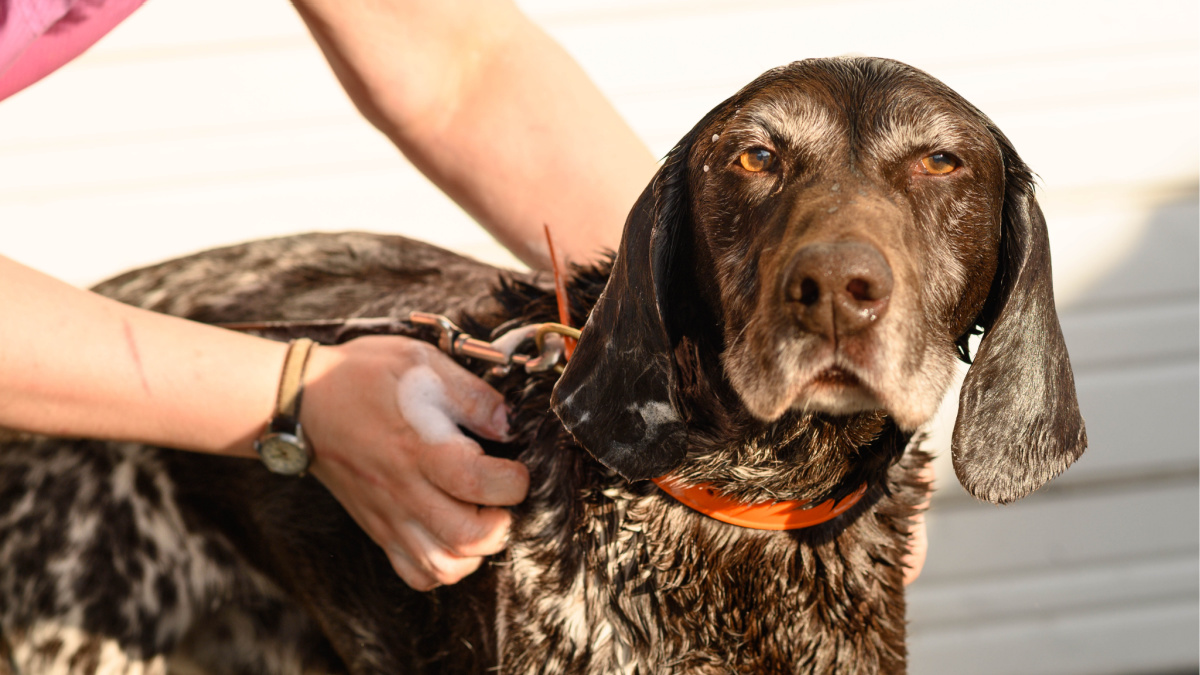
Like bad company or political speeches, nothing lingers quite like the unmistakable scent of dog fur doused in skunk spray.
If you own bird dogs long enough, you’ll likely have to deal with a skunk encounter. While the striking white-on-black markings and raised tail evolved as an aposematic warning sign for predators, high-drive dogs are notorious for learning the hard way.
When that day comes, you’ll find yourself bombarded with home remedies, compelling commercial spray-on products, and unsolicited advice from hunters who have blazed the trail of skunk funk ahead of you. If your bird dog rides shotgun, sleeps in the bed, or otherwise has a temperamental relationship with your significant other, you’ll need an effective remedy… and fast.
While I tend to shy away from home-brewed therapies when it comes to the health of bird dog, in this instance you’ll have the best success by embracing a proven cocktail of items that are already under your sink.
But first, let’s dive into what happens in a skunk encounter and why these particular ingredients work synergistically to clear up the odor.
The Science of the Skunk Spray
Scientists first attempted to isolate the noxious compound of striped skunk (Mephitis mephitis) spray as early as the mid-19th century. Their reports, while heavy in organic chemistry, all included tongue-in-cheek references to their success in alienating colleagues after repeated exposure to the scent. If you’ve lived with a bird dog that has done his own experiments, you can relate to the scent’s remarkable ability to create more elbow room in the dog’s domain.
The research into the exact identity of these compounds has been far from definitive and continues to progress as technology provides more precise methods for isolating them. I won’t bore you with the details. Simply, skunks emit a cocktail of sulfur-rich molecules called thiols, which are responsible for the classic odor we associate with these members of the weasel family.
Some of these compounds are potent enough at high concentrations to cause unconsciousness or even death, but more common clinical signs of exposure include eye irritation, nausea, and irritation to the olfactory system. If your pup has severe symptoms, particularly in the eyes, get a veterinarian involved in the treatment.
The compounds are packaged in yellow, oily secretions produced and stored in the skunk’s modified anal sacs, which are glands similar to those found in the rears of our canine companions. Muscles around the sacs contract to push the contents through tiny, pointed ducts around the skunk’s anus, contributing to the impressive range and marksmanship displayed in this defense mechanism.
The oil-based chemicals allow for rapid uptake into the lipid layer of the skin and form a tight, long-lasting bond with the hair shaft. Some of the thiols are made more aromatic by contact with water, which explains why a swim or bath can unlock the scent (and memories) of a skunk encounter many months in the past.
Tomato Juice Doesn’t Work for Skunk Spray
Tomato juice often comes up as a DIY remedy for a skunk spray encounter. Why this particular treatment came into fashion is unclear, but there’s likely an aromatic compound in the tomato juice that does a decent job of partially masking our ability to detect the putrid odor of the thiols, much in the way your coworkers selected the perfect aerosolized potpourri for the office bathroom that jives well with your intestinal flora.
Ultimately though, the pungent aroma of tomato juice simply does a good job of contributing to olfactory fatigue, a condition in which prolonged exposure to a particular scent desensitizes the nose to its detection over time. In practice, I’ll often get a fresh whiff of skunk on a dog during an exam that the owner assumes faded a long time ago.
While there’s no need to grab a lab coat, the best treatment for combatting these chemical compounds is, in fact, chemistry.
The Best Skunk Smell Remedy for Dogs
Mix a cocktail of 1 quart of 3% hydrogen peroxide, a 1/4 cup of baking soda, and a teaspoon of high-quality liquid detergent (Dawn seems to work well).
Bathe your dog in this solution and let it soak in for 5 minutes, taking care to include the face and muzzle while avoiding the eyes, then rinse. Repeat if necessary. The only caveat is that this cocktail is short-lived once constituted, so in the event your pup needs a second treatment, make a new batch from scratch.
Credit for this recipe is given to chemist Paul Krebaum, and the common household reagents he compiled are similar to those used in breaking down thiols in a laboratory setting. The detergent emulsifies the oils of the anal sac contents, while the peroxide and baking soda chemically convert the skunkiness of thiols into compounds with a different scent profile.
While the skunk avoidance continues to offer the best solution to treat a smelly situation, I’ve personally seen excellent results with this inexpensive recipe.
I’m very familiar with a mother-daughter pair of shorthairs that seem hellbent on ridding the landscape of every skunk they encounter. While they still carry a faint whiff of funk when the wind and humidity are just right, the peroxide/baking soda/soap combo has helped restore their couch access quicker than anything else we’ve tried.




